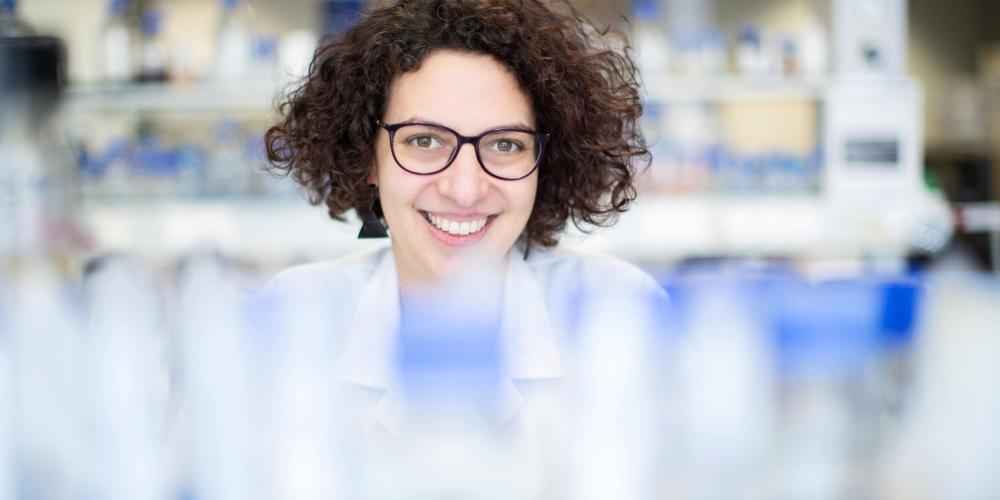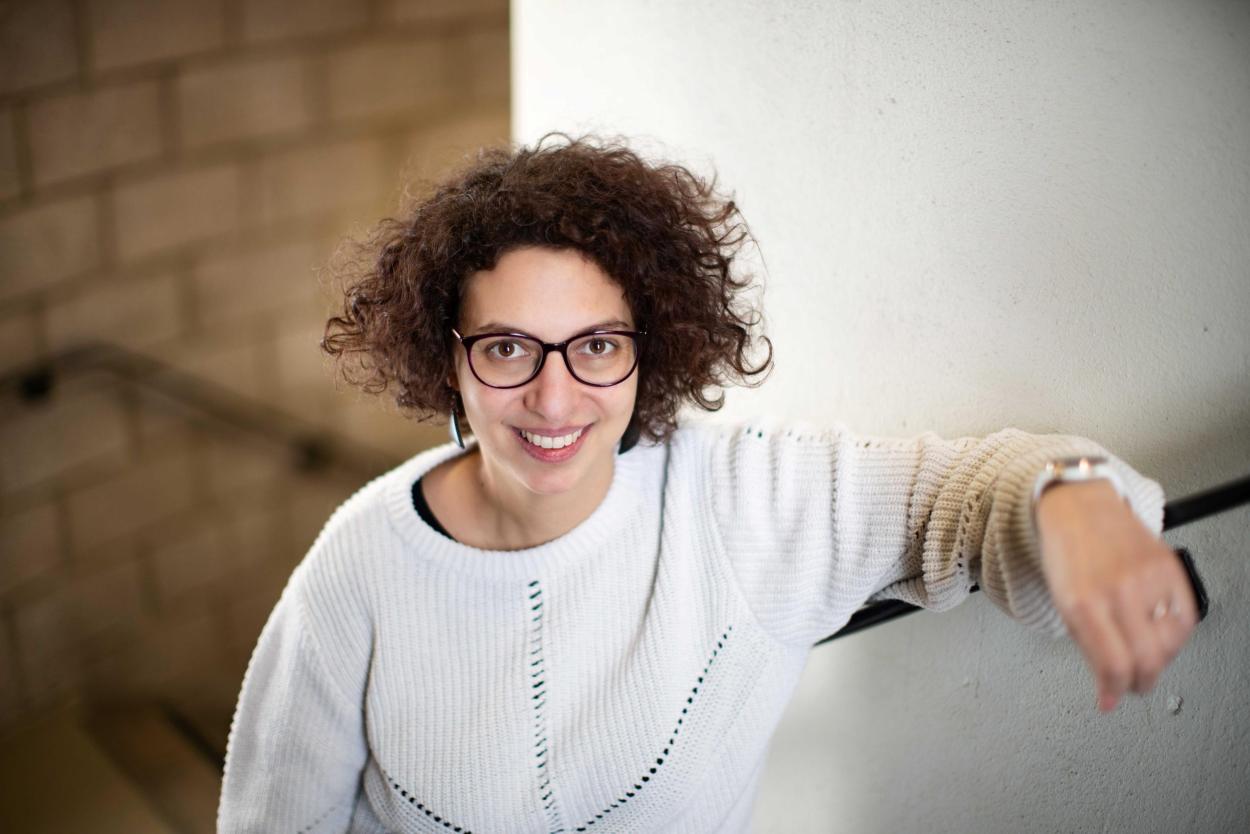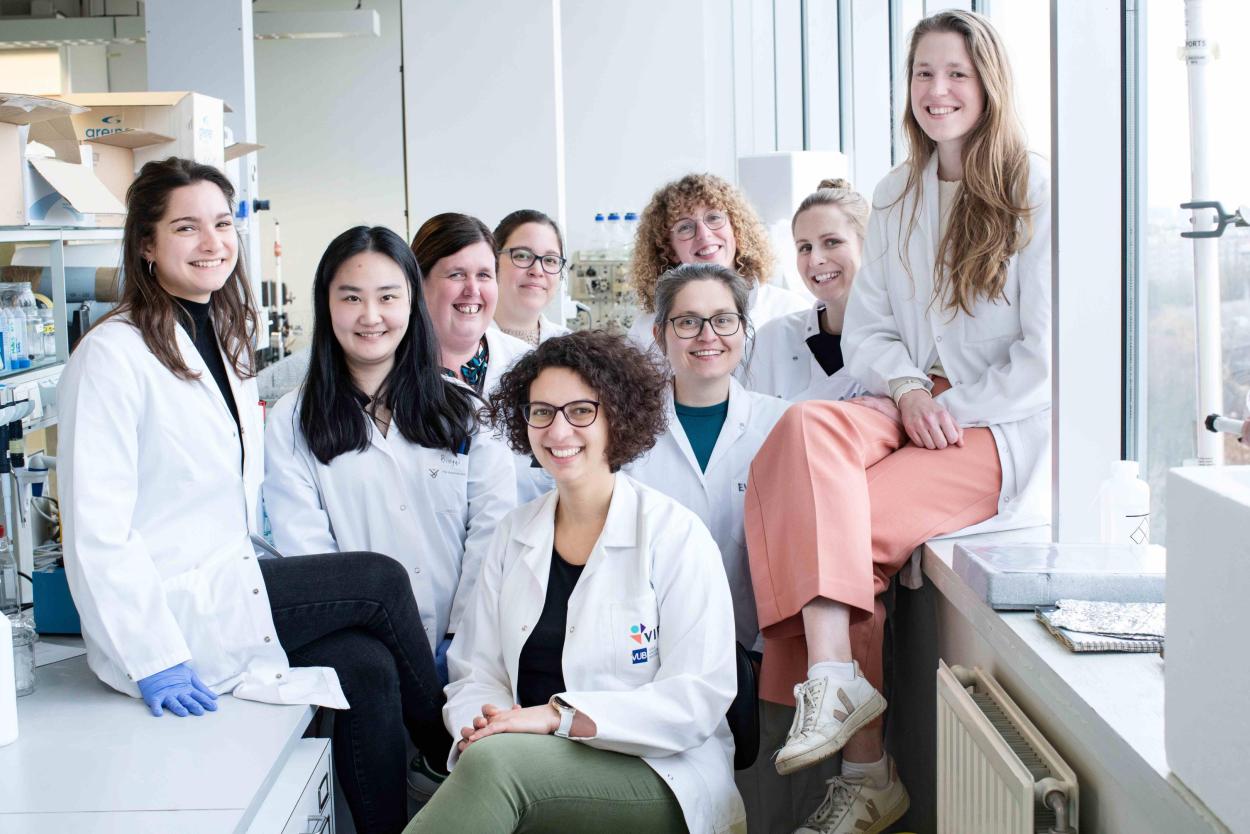
Until recently, doctors had three weapons at their disposal in the fight against cancer: surgery, radiotherapy and chemotherapy. Immunotherapy now completes the therapeutic picture. Will this be the game changer in the treatment of the disease? In any case, immunotherapy is a giant step in the right direction, according to cancer researcher Damya Laoui. “In the future, we are going to increasingly combine immunotherapy and other therapies, completely tailored to the individual patient. Personalised combination therapy will make many types of cancer a controllable, chronic condition.”
Damya Laoui welcomes us on a chilly Monday morning at the Brussels Center for Immunology. We help ourselves to a drink, as Damya is clueless about the coffee machine (“my only pick-me-up is dark chocolate”). The reason for our conversation is World Cancer Day on 4 February. And Damya does not often turn down interviews. Because she is passionate about her field of research, and about seeking funding for her lab. “There are 16 people working here and every experiment is extremely expensive. We use at least €10,000 of research money per week. Either we do less research or we look for more money. I choose the latter. As a result, as much as a quarter of my time goes into fundraising: mainly writing project applications, but also publicising our research and hoping for generous donors. Sometimes this works. A week after I was a guest on the television programme Only Elvis Remains, an anonymous benefactor donated €100,000 to the VUB’s Yamina Krossa Fund (see below). This allowed us to move forward.”

You are doing research on immunotherapy, a relatively new form of cancer therapy. How does it work and who benefits from it?
Damya Laoui: “At the beginning of treatment, chemotherapy often works well, but after a while, resistance can occur. Tumour cells become resistant, just as bacteria become resistant to antibiotics. Immunotherapy is a great addition because it works in a completely different way. Chemotherapy kills rapidly dividing cells, such as cancer cells. Immunotherapy works in a roundabout way: it peps up the body’s immune cells to attack the cancer cells.”
Are there are different types of immunotherapy?
“There are two groups: cell therapies and antibody therapies (see ‘Immunotherapy for dummies’). Antibody therapy is used today in a number of primary and metastatic tumours, such as kidney cancer, melanoma and lung cancer. These are often cancers for which there were few or no effective treatments before. Lung cancer, for example. Thirty per cent of lung cancer patients respond favourably to antibody therapy. Even if metastases are already present. For melanoma, it is also used successfully. Some patients become completely tumour-free, some gain many extra years of life.”
In some people, antibody therapy does not work. Why is that?
“That is being investigated now. It could be due to the patient’s immune system, or the type of cancer cells. We are looking for the ‘markers’ in the DNA of the cells in the patient’s tumour that can predict whether or not this form of immunotherapy will work in a specific patient. Perhaps those people could be helped by combining different types of immunotherapies, or by combining immunotherapy with chemotherapy. The future belongs to personalised therapy. In other words, tailored to the individual patient. That is how we are going to be able to help more and more people.”
That sounds expensive?
“It is. You have to figure out the best approach for each patient individually. But therapies that seem unaffordable today will be affordable tomorrow or the day after. It’s always like that.”
Besides antibody therapy, there is a second form of immunotherapy: cell therapy.
“The best-known form of cell therapy is CAR T cells. T cells are the soldiers of our immune system: they kill cancer cells. In the hospital, blood is taken from the patient. A lab extracts the T cells from that blood and manipulates them so that they attack the tumour cells even better. Thus, the soldiers – the T cells – are pimped into super soldiers, the CAR T cells. These are injected into the patient. CAR T cells are currently still very expensive. They are mainly used in blood cancers, especially in children.”
Your team is investigating another strategy via cell therapy. Can you tell us about that?
“We don’t work with T cells, but with dendritic cells. These could be called the scouts of our immune system. Dendritic cells float around in the body. When they discover a tumour cell, they pick up a piece of it. They take that ‘evidence’ to the T cells, which are found in the lymph nodes and spleen, among others. There, the dendritic cells activate the T cells. These take over the ‘information’ about the tumour cells and set out to destroy them.”
What therapy might emerge from this?
“A therapy by which we hope to prevent relapse and metastasis. That’s why it’s sometimes called a ‘cancer vaccine’. That is sometimes confusing, because it is not a prophylactic vaccine that prevents disease, but a therapeutic vaccine. In other words, an additional weapon in therapy. In practice, we would be better off treating patients first with existing therapies that make their bone marrow produce extra amounts of dendritic cells and also make them highly active. We know that those dendritic cells will then be massively present in the tumour tissue. The tumour is then removed through surgery and goes to the lab, where we extract the dendritic cells. These are then injected back into the patient, float to the T cells in the lymph nodes and prepare both T cells and T memory cells there. So these can spring into action against tumour cells that may not all have been cleared by the treatment and start growing again. We hope that this memory response will help prevent relapse and metastasis.”
And that works?
“In our mouse models it does. We now want to test our strategy in a clinical trial with lung cancer patients. In a later phase, we also want to roll this out for other cancer types such as breast and ovarian cancer. In a first step, we need to test the therapy for safety, in about 20 people. This will be followed by a blind study with 50 to 100 people. Everyone gets the standard treatment first. Then we will treat one half with dendritic cells and the other half with a placebo. We will collaborate with UZ Brussel and other university hospitals for this.”
When is that planned?
“That depends on ethics committee approval and budget. If we have enough money, we can hopefully start in 2026 or 2027.”
Is similar research happening elsewhere?
“Not specifically with tumour-derived dendritic cells, but dendritic cells are currently being researched all over the world. At UZ Brussel, Bart Neyns is also working on dendritic cells, but there they extract them from the blood instead of the tumour.”
Was curing cancer your dream for the future?
“Not right away. Biology fascinated me because I loved nature and animals. During my master’s thesis, a good friend’s mother died of cancer. Then I did think: it would be nice if I could contribute something to the fight against cancer. But above all, I wanted a fun job in which I keep learning. That is the case here. I work with a fantastic team and almost every day we discover something that nobody knows yet. Science is really incredibly cool.”

You come from a family that didn’t have much money. How difficult was your academic path?
“I considered becoming a viola player, but they didn’t think that was a good idea at home. I had to pay for my studies myself. Fortunately, I was well supported and could get summaries of classes from other students, but my studies suffered from having to work. The PhD student who supervised me on my master’s thesis made the suggestion to do a PhD. I didn’t even really know what that was. Besides, my grades were way too bad. Fortunately, an IWT scholarship still existed back then. A distinction was enough – I just had to submit a good project and defend it.”
What about today?
“Unfortunately, that IWT scholarship no longer exists. Talented students with lower marks no longer get in – they can’t join the FWO and I still don’t have enough financial room to pay them. I hope there will be a successor to those IWT scholarships. A lot of talent is being lost there now: smart people who are practical and super-creative and work really hard, but for some reason have lower marks. That is fundamentally unfair.”
Do you focus on diversity in your own team?
“The socio-economic diversity could be even better. So could the mix between men and women: in my team, women are the majority. But there are simply more girls choosing medicine. Half of my team is Belgian, the other half comes from abroad – but even the latter almost all come from a good background. Actually, when recruiting, I pay particular attention to people types. I need brilliant people, who can focus tremendously and come up with brilliant ideas. The problem with those types of people is that sometimes they think too much. That’s why I put them next to colleagues who are very hands-on, practical thinkers, good communicators and kick ass. That combination often works very well.”
Bio Damya Laoui
Prof Damya Laoui graduated as a bioengineer and obtained a PhD in bioengineering from the VUB. She is a cancer researcher at the VUB (Brussels Center for Immunology of the Department of Bioengineering Sciences) and at the VIB, the Flemish Institute of Biotechnology.
Her fundamental research into a cancer therapy against relapse and metastasis is funded, among others, through the VUB-Yamina Krossa Fund. Would you like to support her work? Make a donation to the Yamina Krossa Fund | Vrije Universiteit Brussel (vub.be).

Immunotherapy for dummies
- There are two types of immunotherapy: antibody therapy and cell therapy.
- The best known type of antibody therapy are immune checkpoint inhibitors. These are antibodies that have an inhibitory function in our immune system. How does this work?
- Dendritic cells are the scouts of our immune system. They float around the body looking for cancerous and other potentially dangerous cells. When they detect a tumor cell, they pick up a piece of the tumor cell.
- They take that "evidence" to the T cells, the soldiers of our immune system. These are found in the lymph nodes and spleen, among other places.
- The T cells are activated by the dendritic cells. They take over the "information" about the tumor cells and set out to destroy them.
- This whole process also has an inhibition system built into it. Indeed, T cells activated by dendritic cells can go into overdrive. Then they not only attack the tumor, but can potentially damage healthy tissue as well. A brake - the "checkpoint" - causes the T cell to lower its weapons when it encounters healthy tissue. It is no longer "cytotoxic.
- Problem: tumor cells get this game on, too. When the T cells come along, they manage to push out that same brake. As a result, the T cells also lower their weapons when they meet the tumor cells, and the tumor cells stay alive.
- The solution is antibody therapy, a treatment with immune checkpoint inhibitors. These antibodies bind on the brake so that it can no longer be turned on and the T cells do get back to destroying tumor cells. This immediately explains why immune checkpoint inhibitors can cause side effects, often in the form of skin problems: the T cells can also attack healthy tissue.
- Cell therapy is the second type of immunotherapy. Cell therapy primarily uses T cells, or dendritic cells.